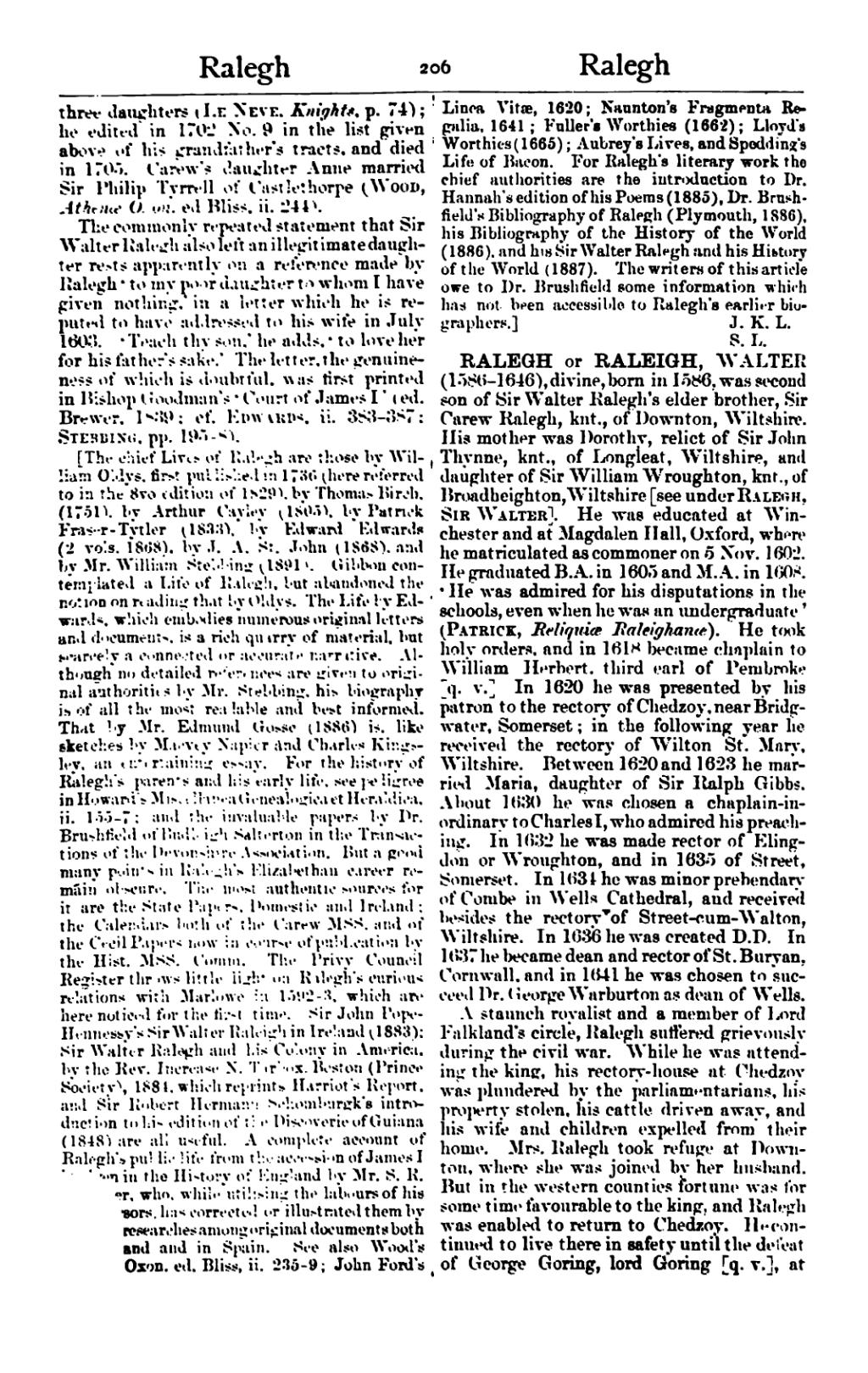three daughters (Le Neve, Knights, p. 74); he edited in 1702 No. 9 in the list given above of his grandfather's tracts, and died in 1705. Carew's daughter Anne married Sir Philip Tyrrell of Castlethorpe (Wood, Athenæ Oxon. ed. Bliss, ii. 244).
The commonly repeated statement that Sir Walter Ralegh also left an illegitimate daughter rests apparently on a reference made by Ralegh ‘to my poor daughter to whom I have given nothing,’ in a letter which he is reputed to have addressed to his wife in July 1603. ‘Teach thy son,’ he adds, ‘to love her for his father's sake.’ The letter, the genuineness of which is doubtful, was first printed in Bishop Goodman's ‘Court of James I’ (ed. Brewer, 1839; cf. Edwards, ii. 383–387; Stebbing, pp. 195–8).
[The chief Lives of Ralegh are those by William Oldys, first published in 1736 (here referred to in the 8vo edition of 1829), by Thomas Birch, (1751), by Arthur Cayley (1805), by Patrick Fraser-Tytler (1833), by Edward Edwards (2 vols. 1868), by J. A. St. John (1868), and by Mr. William Stebbing (1891). Gibbon contemplated a Life of Ralegh, but abandoned the notion on reading that by Oldys. The Life by Edwards, which embodies numerous original letters and documents, is a rich quarry of material, but scarcely a connected or accurate narrative. Although no detailed references are given to original authorities by Mr. Stebbing, his biography is of all the most readable and best informed. That by Mr. Edmund Gosse (1886) is, like sketches by Macvey Napier and Charles Kingsley, an entertaining essay. For the history of Ralegh's parents and his early life, see pedigree in Howard's Miscellanea Genealogica et Heraldica, ii. 155–7; and the invaluable papers by Dr. Brushfield of Budleigh Salterton in the Transactions of the Devonshire Association. But a good many points in Ralegh's Elizabethan career remain obscure. The most authentic sources for it are the State Papers, Domestic and Ireland; the Calendars both of the Carew MSS. and of the Cecil Papers now in course of publication by the Hist. MSS. Comm. The Privy Council Register throws little light on Ralegh's curious relations with Marlowe in 1592–3, which are here noticed for the first time. Sir John Pope-Hennessy's Sir Walter Ralegh in Ireland (1883); Sir Walter Ralegh and his Colony in America, by the Rev. Increase N. Tarbox, Boston (Prince Society), 1884, which reprints Harriot's Report, and Sir Robert Hermann Schomburgk's introduction to his edition of the Discoverie of Guiana (1848) are all useful. A complete account of Ralegh's public life from the accession of James I is given in the History of England by Mr. S. R. Gardiner, who, while utilising the labours of his predecessors, has corrected or illustrated them by his own researches among original documents both in England and in Spain. See also Wood's Athenæ Oxon. ed. Bliss, ii. 235–9; John Ford's Linea Vitæ, 1620; Naunton's Fragmenta Regalia, 1641; Fuller's Worthies (1662); Lloyd's Worthies (1665); Notes and Queries, 8th ser. x. 211; Aubrey's Lives, and Spedding's Life of Bacon. For Ralegh's literary work the chief authorities are the introduction to Dr. Hannah's edition of his Poems (1885), Dr. Brushfield's Bibliography of Ralegh (Plymouth, 1886, new ed. Exeter, 1908), his Bibliography of the History of the World (1886), and his Sir Walter Ralegh and his History of the World (1887). The writers of this article owe to Dr. Brushfield some information which has not been accessible to Ralegh's earlier biographers.]
RALEGH or RALEIGH, WALTER (1586–1646), divine, born in 1586, was second son of Sir Walter Ralegh's elder brother, Sir Carew Ralegh, knt., of Downton, Wiltshire. His mother was Dorothy, relict of Sir John Thynne, knt., of Longleat, Wiltshire, and daughter of Sir William Wroughton, knt., of Broadheighton, Wiltshire [see under Ralegh, Sir Walter]. He was educated at Winchester and at Magdalen Hall, Oxford, where he matriculated as commoner on 5 Nov. 1602. He graduated B.A. in 1605 and M.A. in 1608. ‘He was admired for his disputations in the schools, even when he was an undergraduate’ (Patrick, Reliquiæ Raleighanæ). He took holy orders, and in 1618 became chaplain to William Herbert, third earl of Pembroke [q. v.] In 1620 he was presented by his patron to the rectory of Chedzoy, near Bridgwater, Somerset; in the following year he received the rectory of Wilton St. Mary, Wiltshire. Between 1620 and 1623 he married Maria, daughter of Sir Ralph Gibbs. About 1630 he was chosen a chaplain-in-ordinary to Charles I, who admired his preaching. In 1632 he was made rector of Elingdon or Wroughton, and in 1635 of Street, Somerset. In 1634 he was minor prebendary of Combe in Wells Cathedral, and received besides the rectory of Street-cum-Walton, Wiltshire. In 1636 he was created D.D. In 1637 he became dean and rector of St. Buryan, Cornwall, and in 1641 he was chosen to succeed Dr. George Warburton as dean of Wells.
A staunch royalist and a member of Lord Falkland's circle, Ralegh suffered grievously during the civil war. While he was attending the king, his rectory-house at Chedzoy was plundered by the parliamentarians, his property stolen, his cattle driven away, and his wife and children expelled from their home. Mrs. Ralegh took refuge at Downton, where she was joined by her husband. But in the western counties fortune was for some time favourable to the king, and Ralegh was enabled to return to Chedzoy. He continued to live there in safety until the defeat of George Goring, lord Goring [q. v.], at
